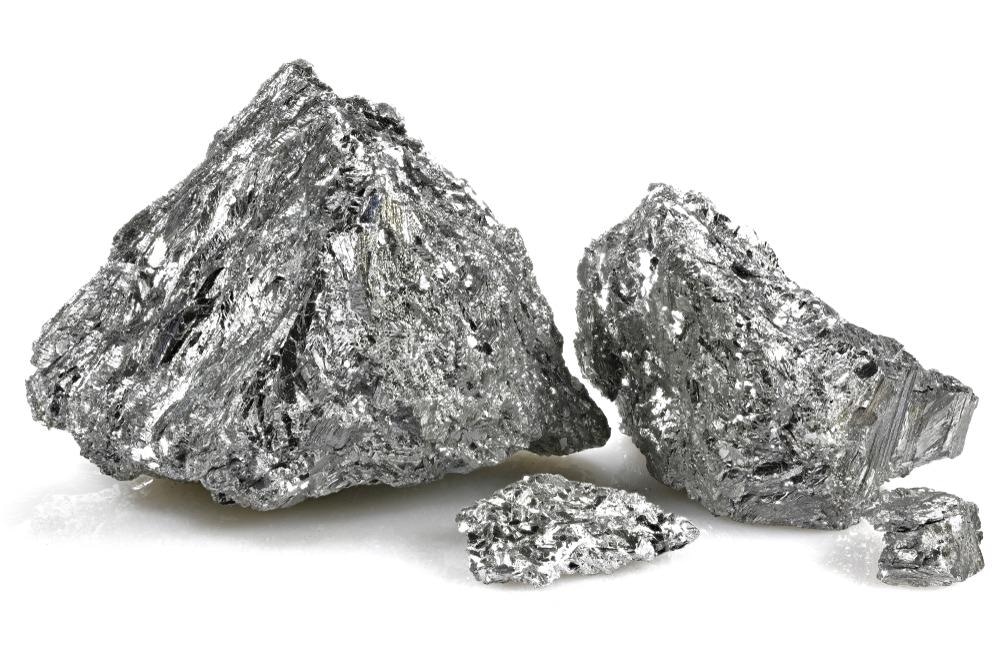Article updated 2nd July 2021

Image Credit: Bjoern Wylezich/Shutterstock.com
Antimony is a metallic element commonly used in the semiconductor industry due to its high charge mobility. However, while it has been traditionally famed for its charge transport capabilities, several recent developments have suggested that antimony thin films may offer some highly desirable, tunable optical properties as well.
Switchable Films
Recent work in Science Advances has demonstrated that antimony thin films can be switched between two distinct states using light pulses, with exciting implications for combining optoelectronics and plasmonics applications.1
The researchers found that when antimony is processed as a nanoscale thin film, the metal can be in either a crystalline or amorphous state, both of which are stable at room temperature. By using a sub-picosecond laser pulse, the metal switches between these two phases completely reversibly.
The two different phases are optically distinguishable. The switching process is relatively rapid, with much better retention times past 30 days from laser-induced switching than thermally driven changes. The bandgap and the refractive index change between the crystalline and amorphous phases give rise to the tunable electronic and optical properties.
Single element metals have generally not been considered viable candidates for tunable optical materials, and it has only been recently that amorphous states of elemental metals have been obtained. For this behavior to be observed for antimony, it must be processed as a thin film of nanometric dimensions.
The high contrast between the phases for antimony and controllable switching may pave the way for photonic memory with smaller footprints and interfaced with electronics. The tunable volatility and retention times may also make antimony thin films attractive candidates in photonic neuromorphic computing to build models of neurons and synapses found in the brain.
Neural Implants
The optical properties of antimony may find applications in building model brains and as a material to be implanted into the brain. Researchers at Lawrence Livermore National Laboratory (LLNL) have been developing Polymeric Opto-Electro-Mechanical Systems to transport light pulses into neural implants.2
Designing neural implants involves finding conductive, lightweight biocompatible materials with excellent long-term stability, either for electrical, or in this case, optical signals.
Polymer-based organic electronics have many excellent properties for this type of application as they tend to be flexible, light, and easily processed. However, one of the challenges of polymer-based-optoelectronics is overcoming their relatively poor efficiencies and optical transmission.
One approach is to create hybrid organic-inorganic polymers that combine many of the advantages with typically exceptionally transmissive inorganic species and the desired physical properties of organic polymers.
The team at LLNL has found a way of doing just this by machining the hybrid polymer materials with microfabrication and 3D printing to create very lightweight flexible devices suitable for implants.
The optical waveguides LLNL have created using this technique have excellent transmission and are sufficiently robust to deliver the necessary optical powers into the brain with no thermal damage to the implant components.
The light sources used were micro light-emitting diodes, and early trials have shown the implants lasting over a year in situ.
The team hopes that developing hybrid organic-inorganic waveguides as part of miniaturized implants will make it possible to use such waveguides for diagnosis, treatment, and long-term research studies on brain activity.
Antimony Properties
There is a significant demand for metamaterials with tunable optical and electronic properties, of which antimony thin films seem to be an attractive target.3 Being able to switch between states under visual control on demand is crucial for memory and computation applications. Moving away from traditional electronic circuits to light-controlled chips would offer considerable advances in the miniaturization of devices.
Many antimony materials blended with other elements are under current investigation for their fast phase switching properties that researchers hope to exploit for the applications above.4 What makes antimony desirable either as a pure thin film or as part of a mixture is that it typically offers high stability, fast switching, and thin films' thicknesses can be tuned to change the carrier density.5
Antimony and other mixed thin films may also prove interesting for their tunable optical applications in various regions of the electromagnetic spectrum.6
References and Further Reading
- Cheng, Z., Milne, T., Salter, P., Kim, J. S., Humphrey, S., Booth, M., & Bhaskaran, H. (2021). Antimony thin films demonstrate programmable optical non-linearity. Science Advances, 7. https://doi.org/10.1126/sciadv.abd7097
- Kampasi, K., Ladner, I., Zhou, J., Calónico Soto, A., Hernandez, J., Patra, S., & Haque, R. ul. (2020). POEMS (Polymeric Opto-Electro-Mechanical Systems) for advanced neural interfaces. Materials Letters, 285, 129015. https://doi.org/10.1016/j.matlet.2020.129015
- Zheludev, N. I. (2015). Obtaining optical properties on demand. Science, 348(6238), 973–974. https://doi.org/10.1126/science.aac4360
- Wen, S., Meng, Y., Jiang, M., & Wang, Y. (2018). Multi-level coding-recoding by ultrafast phase transition on Ge2Sb2Te5 thin films. Scientific Reports, 8(1), 2–9. https://doi.org/10.1038/s41598-018-23360-z
- Fox, T. J., Howson, R. P., & Emmony, D. C. (1974). Optical Properties of Thin Films of Antimony. J. Phys. D: Appl. Phys., 7, 1864–1872. https://doi.org/10.1557/adv.2019.273
- Zaitsev, A. D., Demchenko, P. S., Zykov, D. V, Korotina, E. A., Makarova, E. S., Tkhorzhevskiy, I. L., … Khodzitsky, M. K. (2020). Optical and electronic properties of thin bismuth-antimony films in the terahertz frequency range. In O. A. Romanovskii & Y. V Kistenev (Eds.), Fourth International Conference on Terahertz and Microwave Radiation: Generation, Detection, and Applications (Vol. 11582, pp. 354–357). SPIE. https://doi.org/10.1117/12.2583522
Disclaimer: The views expressed here are those of the author expressed in their private capacity and do not necessarily represent the views of AZoM.com Limited T/A AZoNetwork the owner and operator of this website. This disclaimer forms part of the Terms and conditions of use of this website.